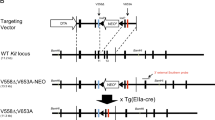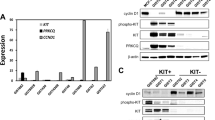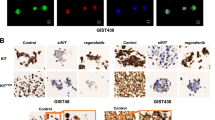Abstract
Gastrointestinal stromal tumor (GIST) is the most common human sarcoma and is typically driven by a single mutation in the Kit or PDGFRA receptor. While highly effective, tyrosine kinase inhibitors (TKIs) are not curative. The natural ligand for the Kit receptor is Kit ligand (KitL), which exists in both soluble and membrane-bound forms. While KitL is known to stimulate human GIST cell lines in vitro, we used a genetically engineered mouse model of GIST containing a common human KIT mutation to investigate the intratumoral sources of KitL, importance of KitL during GIST oncogenesis, and contribution of soluble KitL to tumor growth in vivo. We discovered that in addition to tumor cells, endothelia and smooth muscle cells produced KitL in KitV558Δ/+ tumors, even after imatinib therapy. Genetic reduction of total KitL in tumor cells of KitV558Δ/+ mice impaired tumor growth in vivo. Similarly, genetic reduction of tumor cell soluble KitL in KitV558Δ/+ mice decreased tumor size. By RNA sequencing, quantitative PCR, and immunohistochemistry, KitL expression was heterogeneous in human GIST specimens. In particular, PDGFRA-mutant tumors had much higher KitL expression than Kit-mutant tumors, suggesting the benefit of Kit activation in the absence of mutant KIT. Serum KitL was higher in GIST patients with tumors resistant to imatinib and in those with tumors expressing more KitL RNA. Overall, KitL supports the growth of GIST at baseline and after imatinib therapy and remains a potential biomarker and therapeutic target.
This is a preview of subscription content, access via your institution
Access options
Subscribe to this journal
Receive 50 print issues and online access
$259.00 per year
only $5.18 per issue
Buy this article
- Purchase on Springer Link
- Instant access to full article PDF
Prices may be subject to local taxes which are calculated during checkout





Similar content being viewed by others
Data availability
ScRNAseq data presented in this work are submitted through the Sequencing Read Archive under the accession number PRJNA945239. The remaining data generated and/or analyzed during the current study are available within the article and its Supplementary Data files or are available from the corresponding author upon reasonable request.
References
Joensuu H, DeMatteo RP. The management of gastrointestinal stromal tumors: a model for targeted and multidisciplinary therapy of malignancy. Annu Rev Med. 2012;63:247–58.
Antonescu CR, Besmer P, Guo T, Arkun K, Hom G, Koryotowski B, et al. Acquired resistance to imatinib in gastrointestinal stromal tumor occurs through secondary gene mutation. Clin Cancer Res. 2005;11:4182–90.
Agaram NP, Besmer P, Wong GC, Guo T, Socci ND, Maki RG, et al. Pathologic and molecular heterogeneity in imatinib-stable or imatinib-responsive gastrointestinal stromal tumors. Clin Cancer Res. 2007;13:170–81.
Lyman SD, Jacobsen SE. c-kit ligand and Flt3 ligand: stem/progenitor cell factors with overlapping yet distinct activities. Blood. 1998;91:1101–34.
Huang E, Nocka K, Beier DR, Chu TY, Buck J, Lahm HW, et al. The hematopoietic growth factor KL is encoded by the Sl locus and is the ligand of the c-kit receptor, the gene product of the W locus. Cell 1990;63:225–33.
Lennartsson J, Ronnstrand L. Stem cell factor receptor/c-Kit: from basic science to clinical implications. Physiol Rev. 2012;92:1619–49.
Reber L, Da Silva CA, Frossard N. Stem cell factor and its receptor c-Kit as targets for inflammatory diseases. Eur J Pharm. 2006;533:327–40.
Huang EJ, Nocka KH, Buck J, Besmer P. Differential expression and processing of two cell associated forms of the kit-ligand: KL-1 and KL-2. Mol Biol Cell. 1992;3:349–62.
Heissig B, Hattori K, Dias S, Friedrich M, Ferris B, Hackett NR, et al. Recruitment of stem and progenitor cells from the bone marrow niche requires MMP-9 mediated release of kit-ligand. Cell. 2002;109:625–37.
Miyazawa K, Williams DA, Gotoh A, Nishimaki J, Broxmeyer HE, Toyama K. Membrane-bound Steel factor induces more persistent tyrosine kinase activation and longer life span of c-kit gene-encoded protein than its soluble form. Blood. 1995;85:641–9.
Yasuda A, Sawai H, Takahashi H, Ochi N, Matsuo Y, Funahashi H, et al. Stem cell factor/c-kit receptor signaling enhances the proliferation and invasion of colorectal cancer cells through the PI3K/Akt pathway. Dig Dis Sci. 2007;52:2292–300.
Zhang W, Stoica G, Tasca SI, Kelly KA, Meininger CJ. Modulation of tumor angiogenesis by stem cell factor. Cancer Res. 2000;60:6757–62.
Hida T, Ueda R, Sekido Y, Hibi K, Matsuda R, Ariyoshi Y, et al. Ectopic expression of c-kit in small-cell lung cancer. Int J Cancer Suppl. 1994;8:108–9.
Krystal GW, Hines SJ, Organ CP. Autocrine growth of small cell lung cancer mediated by coexpression of c-kit and stem cell factor. Cancer Res. 1996;56:370–6.
Hayashi Y, Asuzu DT, Gibbons SJ, Aarsvold KH, Bardsley MR, Lomberk GA, et al. Membrane-to-nucleus signaling links insulin-like growth factor-1- and stem cell factor-activated pathways. PLoS One. 2013;8:e76822.
Bono P, Krause A, von Mehren M, Heinrich MC, Blanke CD, Dimitrijevic S, et al. Serum KIT and KIT ligand levels in patients with gastrointestinal stromal tumors treated with imatinib. Blood. 2004;103:2929–35.
Hirano K, Shishido-Hara Y, Kitazawa A, Kojima K, Sumiishi A, Umino M, et al. Expression of stem cell factor (SCF), a KIT ligand, in gastrointestinal stromal tumors (GISTs): a potential marker for tumor proliferation. Pathol Res Pract. 2008;204:799–807.
Theou-Anton N, Tabone S, Brouty-Boye D, Saffroy R, Ronnstrand L, Lemoine A, et al. Co expression of SCF and KIT in gastrointestinal stromal tumours (GISTs) suggests an autocrine/paracrine mechanism. Br J Cancer. 2006;94:1180–5.
Sommer G, Agosti V, Ehlers I, Rossi F, Corbacioglu S, Farkas J, et al. Gastrointestinal stromal tumors in a mouse model by targeted mutation of the Kit receptor tyrosine kinase. Proc Natl Acad Sci USA. 2003;100:6706–11.
Hou XW, Bai CG, Liu XH, Qiu C, Huang L, Xu JJ, et al. Expression of stem cell factor in gastrointestinal stromal tumors: Implications for proliferation and imatinib resistance. Oncol Lett. 2013;5:552–8.
Kim TS, Cavnar MJ, Cohen NA, Sorenson EC, Greer JB, Seifert AM, et al. Increased KIT inhibition enhances therapeutic efficacy in gastrointestinal stromal tumor. Clin Cancer Res. 2014;20:2350–62.
Ding L, Saunders TL, Enikolopov G, Morrison SJ. Endothelial and perivascular cells maintain haematopoietic stem cells. Nature. 2012;481:457–62.
Da Silva CA, Heilbock C, Kassel O, Frossard N. Transcription of stem cell factor (SCF) is potentiated by glucocorticoids and interleukin-1beta through concerted regulation of a GRE-like and an NF-kappaB response element. FASEB J. 2003;17:2334–6.
Grimaldi P, Capolunghi F, Geremia R, Rossi P. Cyclic adenosine monophosphate (cAMP) stimulation of the kit ligand promoter in sertoli cells requires an Sp1-binding region, a canonical TATA box, and a cAMP-induced factor binding to an immediately downstream GC-rich element. Biol Reprod. 2003;69:1979–88.
Hue J, Kim A, Song H, Choi I, Park H, Kim T, et al. IL-18 enhances SCF production of melanoma cells by regulating ROI and p38 MAPK activity. Immunol Lett. 2005;96:211–7.
Hollenbeck ST, Sakakibara K, Faries PL, Workhu B, Liu B, Kent KC. Stem cell factor and c-kit are expressed by and may affect vascular SMCs through an autocrine pathway. J Surg Res. 2004;120:288–94.
Tieniber AD, Hanna AN, Do K, Wang L, Rossi F, DeMatteo RP. Molecular and immunologic techniques in a genetically engineered mouse model of gastrointestinal stromal tumor. J Vis Exp. 2022.
Rossi F, Ehlers I, Agosti V, Socci ND, Viale A, Sommer G, et al. Oncogenic Kit signaling and therapeutic intervention in a mouse model of gastrointestinal stromal tumor. Proc Natl Acad Sci USA. 2006;103:12843–8.
Vitiello GA, Bowler TG, Liu M, Medina BD, Zhang JQ, Param NJ, et al. Differential immune profiles distinguish the mutational subtypes of gastrointestinal stromal tumor. J Clin Investig. 2019;129:1863–77.
Han ZB, Ren H, Zhao H, Chi Y, Chen K, Zhou B, et al. Hypoxia-inducible factor (HIF)-1 alpha directly enhances the transcriptional activity of stem cell factor (SCF) in response to hypoxia and epidermal growth factor (EGF). Carcinogenesis. 2008;29:1853–61.
Cohen NA, Zeng S, Seifert AM, Kim TS, Sorenson EC, Greer JB, et al. Pharmacological inhibition of KIT activates MET signaling in gastrointestinal stromal tumors. Cancer Res. 2015;75:2061–70.
Treff NR, Dement GA, Adair JE, Britt RL, Nie R, Shima JE, et al. Human KIT ligand promoter is positively regulated by HMGA1 in breast and ovarian cancer cells. Oncogene. 2004;23:8557–62.
Balachandran VP, Cavnar MJ, Zeng S, Bamboat ZM, Ocuin LM, Obaid H, et al. Imatinib potentiates antitumor T cell responses in gastrointestinal stromal tumor through the inhibition of Ido. Nat Med. 2011;17:1094–100.
Asik M, Karakus S, Haznedaroglu IC, Goker H, Ozatli D, Buyukasik Y, et al. Bone marrow and peripheral blood C-kit ligand concentrations in patients with thrombocytosis and thrombocytopenia. Hematology. 2003;8:369–73.
Horvath VJ, Vittal H, Lorincz A, Chen H, Almeida-Porada G, Redelman D, et al. Reduced stem cell factor links smooth myopathy and loss of interstitial cells of cajal in murine diabetic gastroparesis. Gastroenterology. 2006;130:759–70.
Tajima Y, Moore MA, Soares V, Ono M, Kissel H, Besmer P. Consequences of exclusive expression in vivo of Kit-ligand lacking the major proteolytic cleavage site. Proc Natl Acad Sci USA. 1998;95:11903–8.
Hynes NE, Lane HA. ERBB receptors and cancer: the complexity of targeted inhibitors. Nat Rev Cancer. 2005;5:341–54.
Matsumoto K, Umitsu M, De Silva DM, Roy A, Bottaro DP. Hepatocyte growth factor/MET in cancer progression and biomarker discovery. Cancer Sci. 2017;108:296–307.
Okamoto W, Okamoto I, Tanaka K, Hatashita E, Yamada Y, Kuwata K, et al. TAK-701, a humanized monoclonal antibody to hepatocyte growth factor, reverses gefitinib resistance induced by tumor-derived HGF in non-small cell lung cancer with an EGFR mutation. Mol Cancer Ther. 2010;9:2785–92.
Yee NS, Hsiau CW, Serve H, Vosseller K, Besmer P. Mechanism of down-regulation of c-kit receptor. Roles of receptor tyrosine kinase, phosphatidylinositol 3'-kinase, and protein kinase C. J Biol Chem. 1994;269:31991–8.
Shimizu Y, Ashman LK, Du Z, Schwartz LB. Internalization of Kit together with stem cell factor on human fetal liver-derived mast cells: new protein and RNA synthesis are required for reappearance of Kit. J Immunol. 1996;156:3443–9.
Lemmon MA, Pinchasi D, Zhou M, Lax I, Schlessinger J. Kit receptor dimerization is driven by bivalent binding of stem cell factor. J Biol Chem. 1997;272:6311–7.
Liu H, Chen X, Focia PJ, He X. Structural basis for stem cell factor-KIT signaling and activation of class III receptor tyrosine kinases. EMBO J. 2007;26:891–901.
Yuzawa S, Opatowsky Y, Zhang Z, Mandiyan V, Lax I, Schlessinger J. Structural basis for activation of the receptor tyrosine kinase KIT by stem cell factor. Cell. 2007;130:323–34.
Krimmer SG, Bertoletti N, Suzuki Y, Katic L, Mohanty J, Shu S, et al. Cryo-EM analyses of KIT and oncogenic mutants reveal structural oncogenic plasticity and a target for therapeutic intervention. Proc Natl Acad Sci USA. 2023;120:e2300054120.
Huang Z, Ruan HB, Xian L, Chen W, Jiang S, Song A, et al. The stem cell factor/Kit signalling pathway regulates mitochondrial function and energy expenditure. Nat Commun. 2014;5:4282.
Merchant JL, Du M, Todisco A. Sp1 phosphorylation by Erk 2 stimulates DNA binding. Biochem Biophys Res Commun. 1999;254:454–61.
Minet E, Ernest I, Michel G, Roland I, Remacle J, Raes M, et al. HIF1A gene transcription is dependent on a core promoter sequence encompassing activating and inhibiting sequences located upstream from the transcription initiation site and cis elements located within the 5'UTR. Biochem Biophys Res Commun. 1999;261:534–40.
Toyota M, Hinoda Y, Takaoka A, Makiguchi Y, Takahashi T, Itoh F, et al. Expression of c-kit and kit ligand in human colon carcinoma cells. Tumour Biol. 1993;14:295–302.
Bai C, Liu X, Qiu C, Zheng J. FoxM1 is regulated by both HIF-1alpha and HIF-2alpha and contributes to gastrointestinal stromal tumor progression. Gastric Cancer. 2019;22:91–103.
Huynh K. Meteorin-like protein repairs the ischaemic heart via receptor KIT in endothelial cells. Nat Rev Cardiol. 2022;19:575.
Medina BD, Liu M, Vitiello GA, Seifert AM, Zeng S, Bowler T, et al. Oncogenic kinase inhibition limits Batf3-dependent dendritic cell development and antitumor immunity. J Exp Med. 2019;216:1359–76.
Tieniber AD, Hanna AN, Medina BD, Vitiello GA, Etherington MS, Liu M, et al. Tyrosine kinase inhibition alters intratumoral CD8 + T-cell subtype composition and activity. Cancer Immunol Res. 2022;10:1210–23.
Medina BD, Liu M, Vitiello GA, Seifert AM, Zeng S, Bowler T, et al. Oncogenic kinase inhibition limits Batf3-dependent dendritic cell development and antitumor immunity. J Exp Med. 2019;216:1359–76.
Seifert AM, Zeng S, Zhang JQ, Kim TS, Cohen NA, Beckman MJ, et al. PD-1/PD-L1 blockade enhances T-cell activity and antitumor efficacy of imatinib in gastrointestinal stromal tumors. Clin Cancer Res. 2017;23:454–65.
Vitiello GA, Medina BD, Zeng S, Bowler TG, Zhang JQ, Loo JK, et al. Mitochondrial inhibition augments the efficacy of imatinib by resetting the metabolic phenotype of gastrointestinal stromal tumor. Clin Cancer Res. 2018;24:972–84.
Satija R, Farrell JA, Gennert D, Schier AF, Regev A. Spatial reconstruction of single-cell gene expression data. Nat Biotechnol. 2015;33:495–502.
Hafemeister C, Satija R. Normalization and variance stabilization of single-cell RNA-seq data using regularized negative binomial regression. Genome Biol. 2019;20:296.
Liu M, Etherington MS, Hanna A, Medina BD, Vitiello GA, Bowler TG, et al. Oncogenic KIT modulates Type I IFN-mediated antitumor immunity in GIST. Cancer Immunol Res. 2021;9:542–53.
Funding
The investigators were supported by NIH grants R01 CA102613 and T32 CA251063 (RPD).
Author information
Authors and Affiliations
Contributions
ADT: Conceptualization, data curation, formal analysis, validation, investigation, methodology, writing–original draft, writing—review and editing. FR: Conceptualization, data curation, formal analysis, validation, investigation, methodology, writing–original draft, writing–review and editing. ANH: Conceptualization, data curation, formal analysis, validation, writing–review and editing. ML: Conceptualization, Data curation, formal analysis. MSE: Data curation, formal analysis. JKL: Data curation, formal analysis. N. Param: Data curation, formal analysis. SZ: Data curation, formal analysis. KJD: Data curation, validation. LW: Data curation, validation. RPD: Conceptualization, resources, supervision, funding acquisition, writing–original draft, project administration, writing–review and editing.
Corresponding author
Ethics declarations
Competing interests
Research grant from BluePrint Medicines (RPD). The authors declare no potential conflicts of interest.
Additional information
Publisher’s note Springer Nature remains neutral with regard to jurisdictional claims in published maps and institutional affiliations.
Supplementary information
Rights and permissions
Springer Nature or its licensor (e.g. a society or other partner) holds exclusive rights to this article under a publishing agreement with the author(s) or other rightsholder(s); author self-archiving of the accepted manuscript version of this article is solely governed by the terms of such publishing agreement and applicable law.
About this article
Cite this article
Tieniber, A.D., Rossi, F., Hanna, A.N. et al. Multiple intratumoral sources of kit ligand promote gastrointestinal stromal tumor. Oncogene 42, 2578–2588 (2023). https://doi.org/10.1038/s41388-023-02777-5
Received:
Revised:
Accepted:
Published:
Issue Date:
DOI: https://doi.org/10.1038/s41388-023-02777-5



